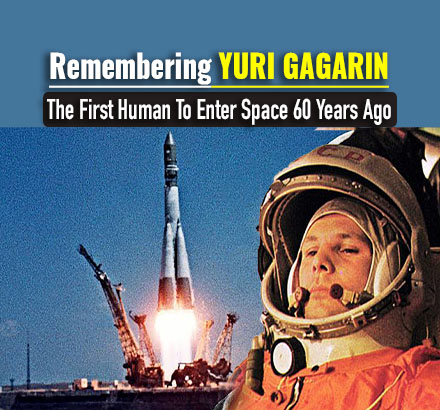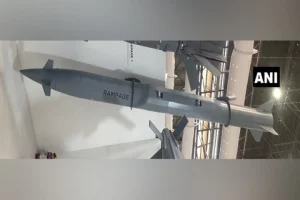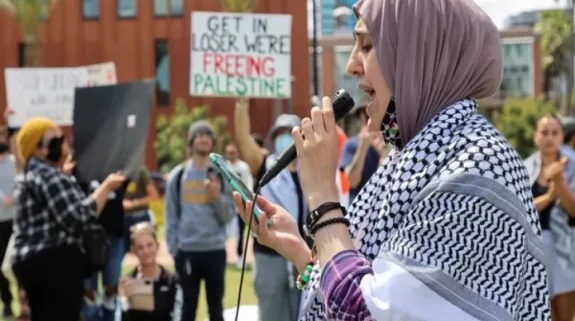Yuri Alekseyevich Gagarin was a Russian pilot and cosmonaut who became the first human to journey into outer space, achieving a major milestone in the Space Race. His capsule, Vostok 1, completed one orbit of Earth on 12 April 1961.
Yuri Gagarin was born on 9 March 1934 in a small village called Klushino near Moscow, Russia. His father Alexey Ivanovich was a carpenter and his mother Anna Timofeyevna was a milkmaid. As well as Yuri the couple had three other children, a boy called Valentin, a girl called Zoya and another boy called Boris..jpg)
Gagarin family home in Klushino (Source: Wikipedia)
When the Nazi’s advanced on Moscow during the second World War, Valentin and Zoya, Yuri’s older brother and sister were forced to move to Poland as slave labour in 1943 and they were not seen again until after the war ended in 1945.
In 1946, the nearby town of Gzhatsk became the new home for the gagarins and Yuri was able to continue his education there.
Yuri Gagarin with his siblings
Yuri Gagarin was graduated in 1951 and entered into a training program to study tractors at the Saratov Industrial Technical School. At the weekend he trained as a Soviet air cadet at a flying club near to Saratov and learned to fly. As he was also near to the Volga River, Yuri also earned extra money as a dock labourer.
Yuri joins the Soviet Air Force in 1955, as he was already a pilot, he was sent to the Air Force Pilot’s school located in Orenburg, near to the border of Kazakhstan. There, he learned to fly the MiG-15 jet fighter and took his first solo flight in the plane on 1957.
Gagarin as an air cadet in the Saratov flying club (Source: Wikipedia)
In 1959 he was training to become a cosmonaut. By this time Soviet space program was accelerating and the race was on against the United States to be the first to put a man into space and so, the search was on to find willing and able pilots.
In 1960, Gagarin was selected along with 19 other candidates for the Vostok 1 program. Eventually the program was narrowed down to two possible candidates. Gagarin and Gheman Titov both had excellent performance in their training and were short enough to fit in the Vastok cockpit. Gagarin was selected because of the other candidates voted for him, for his excellent skills, fast reactions and mathematical skills.
At age 27, on the morning of 12th April 1961 cosmonaut Yuri Gagarin was helped into his space suit and made his way to the launch pad, he climbed into the Vastok spacecraft. Wondering if he would return back to earth but was calm. At 09:07 A.M Moscow time as the engine rumbled Gagrin said “Let’s go.” The rocket blasted off into space and in 10 minutes the Vastok spacecraft separated from the launch rocket.
Gagarin was in space, he crossed the Atlantic Ocean then the Pacific Ocean and his spacecraft passed over Africa, he prepared to re-enter the Earth’s atmosphere, which would not easy. The five first-stage engines fired until the first separation event, when the four side-boosters fell away, leaving the core engine. The core stage then separated while the rocket was in a suborbital trajectory, and the upper stage carried it to orbit. Once the upper stage finished firing, it separated from the spacecraft, which orbited for 108 minutes before returning to Earth in Kazakhstan. Gagarin became the first human to orbit the Earth. As he re-entered Earth’s atmosphere he experience forces up to eight times the pull of gravity. At about 7,000 metres (23,000 ft), Gagarin ejected from the descending capsule as planned and landed using a parachute near Volga river. 
Gagarin's Vostok 3KA capsule and an effigy of him on display at the RKK Energiya museum in 2010 (Source: Wikipedia)
"The feeling of weightlessness was somewhat unfamiliar compared with Earth conditions. Here, you feel as if you were hanging in a horizontal position in straps. You feel as if you are suspended", Gagarin wrote in his post-flight report.
Yuri Gagarin was made a national hero of the Soviet Union. He became a global celebrity. He was paraded through the streets of Moscow on his way to a ceremony at the Kremlin where Nikita Khrushchev awarded him Hero of the Soviet Union. 
Gagarin in Warsaw, 1961(Source: Wikipedia)
In 1962 Yuri Gagarin was elected to serve as Deputy to the Soviet of the Union, which is one of the two chambers of the Supreme Soviet of the USSR. He was also elected to the Central Committee of the young Communist League and returned to the cosmonaut facility at Star city to work on design for reusable spacecraft. Later he was also promoted to lieutenant colonel and then again to colonel.
During this time gagarin was the backup pilot for Vladimir Komarov who was due to fly in Soyuz 1 and despite Gagarin’s concern that additional safety precautions had not been implemented, Soyuz 1 was launched. It crashed on its return after a parachute failure and Komarov was killed. The accident led to the authorities banning Gagarin from further space flight missions due to concerns about losing a national hero in just such an accident.
Yuri Gagarin became a deputy training director at star city on 20 December 1963 and in 1966 he began training to re-qualify as a fighter pilot.
He died on march 27th 1968, during an accident in a military training flight with his flight instructor Vladimir Seryogin. The bodies of both the pilots were cremated and their ashes interred in the walls of the Kremlin. He was just 34 years old..jpg)
A MiG-15UTI, the same type as Gagarin was flying when he was killed (Source: Wikipedia)
Gagarin became an international celebrity and was awarded many medals and titles, including Hero of the Soviet Union, his nation's highest honour. Neil Armstrong and Buzz Aldrin left a memorial satchel containing medals in honour of Gagarin and Komarov on the moon during the apollo 11 mission and the Cosmonaut Training centre in star city was renamed after him. In 1968 the town of Gzhatsk where he grew up after the war was also renamed. It is now simply called Gagarin in his honour of its hero.
Yuri Gagarin with awards
There are statues of Gagarin and monuments to him located in the town named after him as well as in Cheboksary, Orenburg, Komsomolsk-on-Amur, and Yoshkar-Ola in Russia, as well as in Cyprus, Ukraine, Nicosia and Kazakhstan.
Yuri Gagarin statue at the Royal Greenwich Observatory in London




















